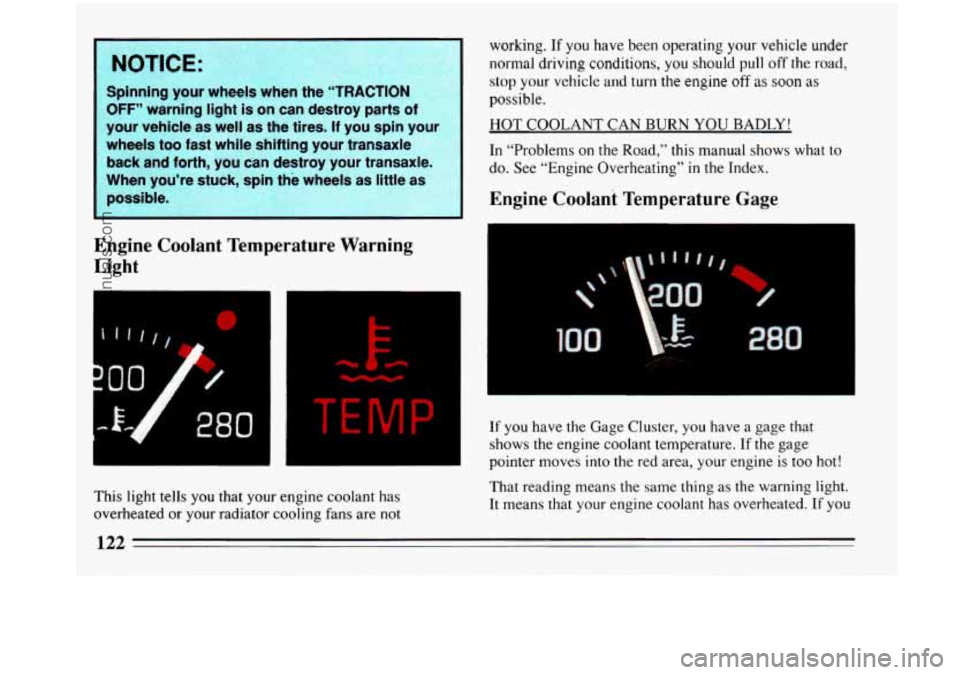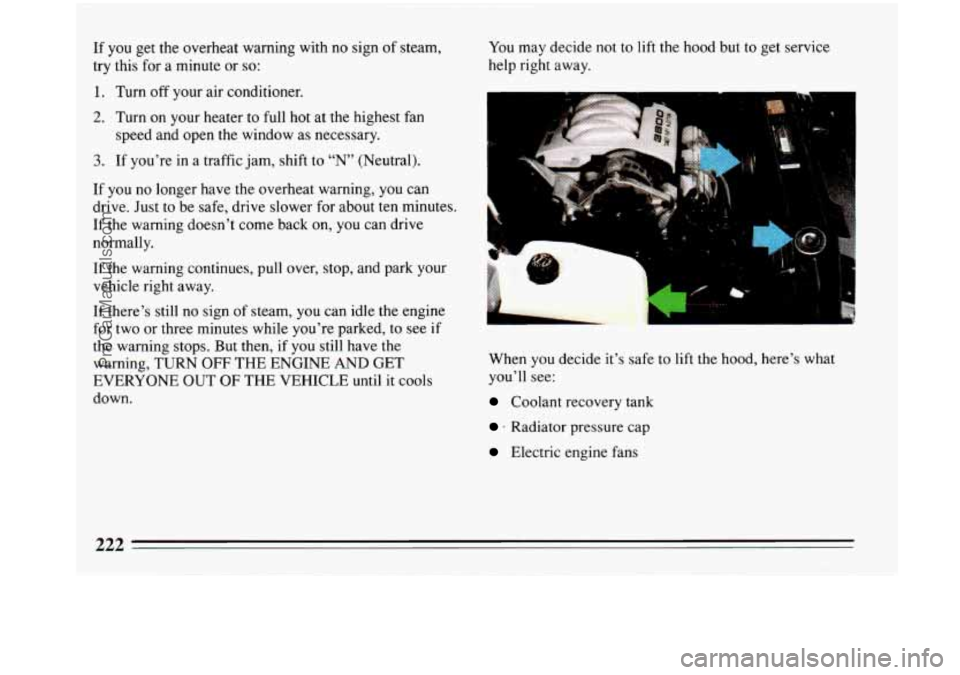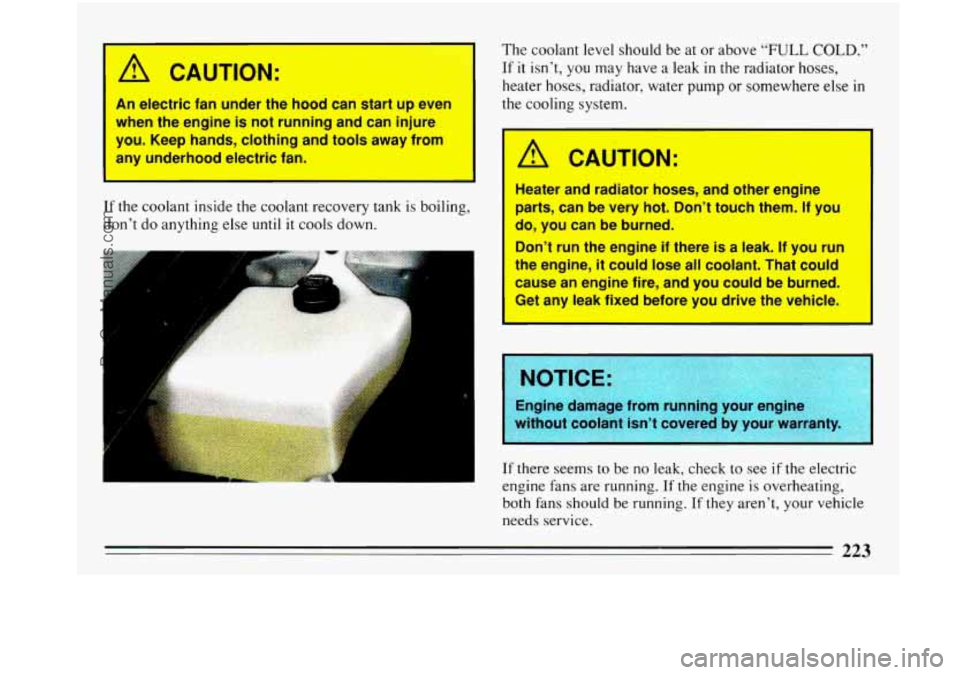Page 14 of 340
!
!
Vehicle Symbols
These are some of the symbols you will find on your vehicle.
For example,
these symbols
are used on an
original battery:
POSSIBLE A
CAUTION
INJURY
PROTECT
EYES BY
SHIELDING
CAUSTIC
ACID COULD BATTERY
CAUSE
BURNS
SPARK
OR ,\I/,
COULD FLAME
EXPLODE BATTERY
These symbols are important
for you and
your passengers
whenever your
vehicle is
driven:
DOOR LOCK
UNLOCK
FASTEN SEAT
4
BELTS
POWER
WINDOW
These symbols have to do with
your lights:
LIGHTS PC
HIGH BEAM OR = =o
FOG LAMPS $0
These symbols
are on some
of
your controls:
WINDSHIELD ' ' '
WASHER
l0 'r' -1
WINDSHIELD 6$
WASHER 8
WINDSHIELD
DEFROSTER
WINDOW
DEFOGGER
VENTILATING FAN
3f
HEADLAMP -
WIPER -
WASHER iQ
These symbols
are used on
warning and
indicator lights:
COOLANT F-
TEMP --
ENGINE
RADIATOR
a
COOLANT
FUEL
ENGINE OIL wb
PRESSURE
TEMP
OIL &4
ANTILOCK (a)
BRAKE
Here are some
other symbols
you may see:
FUSE
RADIO
>
VOLUME
HATCHBACK
e
TRUNK
RELEASE
LIGHTER
1-1
HORN )tr
SPEAKER
b
ProCarManuals.com
Page 124 of 340

I NOTICE:
Spinning your wheels when the “TRACTION
OFF” warning light is on can destroy parts of
your vehicle as well as the tires.
If you spin your
wheels too fast while shifting your transaxle
back and forth, you can destroy your transaxle.
When you’re stuck, spin the wheels
as little as
possible.
~~~~~~
1
working. If you have been operating your vehicle under
normal driving conditions,
you should pull off the road,
Engine Coolant Temperature Warning
Light
7
280
stop your vehicle and turn the engine off as soon as
possible.
HOT COOLANT CAN BURN YOU BADLY!
In “Problems
on the Road,” this manual shows what to
do. See “Engine Overheating”
in the Index.
Engine Coolant Temperature Gage
100
.Id pointer moves into the red area, your engine is too hot!
If you have the Gage Cluster, you have a gage that
shows the engine coolant temperature.
If the gage
This light
tells you that your engine coolant has
overheated or your radiator cooling fans are
not
That reading means the same thing as the warning light.
It means that your engine coolant has overheated.
If you
122
ProCarManuals.com
Page 221 of 340
Front Towing Hook- JPS
Attach "T" hook chains
behind the front wheels into
the bottom
slots of the
cradle rails on both sides Position a
4" x 4" wood beam
across the sling chains
contacting the bottom of the radiator support. Position
the lower sling crossbar just behind the rear edge of the
front bumper.
219
ProCarManuals.com
Page 224 of 340

If you get the overheat warning with no sign of steam,
try this for a minute or
so:
1. Turn off your air conditioner.
2. Turn on your heater to full hot at the highest fan
speed and open the window as necessary.
3. If you’re in a traffic jam, shift to “N” (Neutral).
If
you no longer have the overheat warning, you can
drive. Just
to be safe, drive slower for about ten minutes.
If the warning doesn’t come back on,
you can drive
normally.
If the warning continues, pull over, stop, and park your
vehicle right away.
If there’s still no sign of steam, you can idle the engine
for two or three minutes while you’re parked, to see if
the warning stops. But then, if
you still have the
warning, TURN
OFF THE ENGINE AND GET
EVERYONE OUT
OF THE VEHICLE until it cools
down. You
may decide not to lift the hood but to get service
help right away.
e
w . ._
,
When you decide it’s safe to lift the hood, here’s what
you’ll see:
Coolant recovery tank
* Radiator pressure cap
Electric engine fans
ProCarManuals.com
Page 225 of 340

I A CAUTION:
An electric fan under the hood can start up even
when the engine
is not running and can injure
you. Keep hands, clothing and tools away from
any underhood electric fan.
If the coolant inside the coolant recovery tank is boiling,
don’t do anything else until it cools down.
. .” P
The coolant level should be at or above “FULL COLD.”
If it isn’t, you may have a leak in the radiator hoses,
heater hoses, radiator, water pump
or somewhere else in
the cooling system.
I I
A CAUTION:
Heater and radiator hoses, and other engine
parts, can be very hot. Don’t touch them.
If you
do, you can be burned.
Don’t run the engine
if there is a leak. If you run
the engine, it could lose all coolant. That could
cause an engine fire, and you could be burned.
Get any leak fixed before you drive the vehicle.
I
Engine damage? Il’onl I mning bUrlr engine
without coolant isn’t covered by your warrbllr
If there seems to be no leak, check to see if the electric
engine fans are running. If the engine
is overheating,
both fans should be running. If they aren’t, your vehicle
needs service.
223
ProCarManuals.com
Page 227 of 340
A CAUTION: A CAUTION:
You can be burned if you spill cootant on hot
engine parts. Coolant contains ethylene glycol
and it will burn if the engine parts are hot
enough. Don’t spill coolant on a hot engine.
When the coolant in the coolant recovery tank is at or
above
“FULL COLD,” start your vehicle.
If the overheat warning continues, there’s one more
thing you can try.
You can add the proper coolant mix
directly
to the radiator, but be sure the cooling system is
cool before
you do it.
Steam and scalding liquids from a hot cooling
system can blow out and burn you badly. They
are under pressure, and if you turn the radiator
pressure cap
-- even a little -- they can come out
at high speed. Never turn the pressure cap when
e cooling system, including the radiator
pressure cap, is hot. Wait for the cooling system
and radiator pressure cap to cool
if you ever
have
to turn the pressure cap.
L
L
ProCarManuals.com
Page 228 of 340
How to Add Coolant to the Radiator
1 1. You can remove the
radiator pressure cap when the
cooling system,
including the
radiator pressure
cap and upper
radiator hose,
is no
longer hot.
Turn the pressure cap slowly to the
left until it first
stops. (Don't press
down while turning the pressure
cap.)
2. Then keep turning the pressure cap,
but now push down
as
you turn it.
Remove the
pressure cap.
1
If you hear a hiss, wait for that to stop. A hiss means I
there is still some pressure left. i
3. Fill the radiator
with the proper
mix, up to the base
of the filler neck.
ProCarManuals.com
Page 229 of 340
4. Then fill the coolant recovery tank to “FULL
COLD.”
6. Start the engine and
let it run until you
can feel the upper
radiator hose
getting hot. Watch
out for the engine
fans.
7. By this time the coolant level inside the radiator
filler neck may be lower. If the level
is lower, add
more of the proper
mix through the filler neck until
the level reaches the top
of the filler neck.
5. Put the cap back on the coolant recovery tank, but
leave
the radiator pressure cap off.
227
ProCarManuals.com